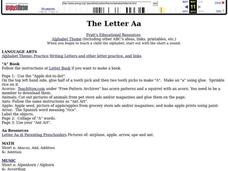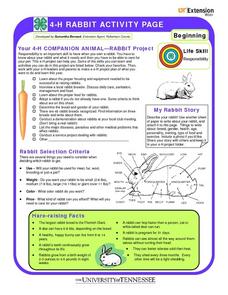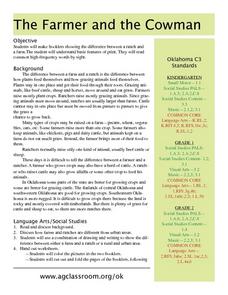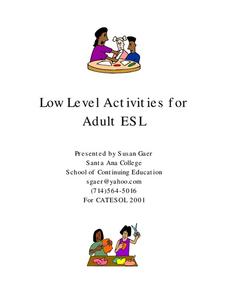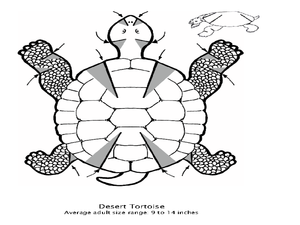Curated OER
Spanish Sentence Structure
Instruct your class on how to put together a sentence in Spanish. The resource covers the different parts of speech, showing how the Spanish version of each sentence compares with the English version. While there are no procedures...
Ask a Biologist
It’s a Plankton Eat Plankton World
For as small as they are, plankton sure play an enormous role in maintaining marine ecosystems. Dive into an investigation of these tiny organisms with a hands-on life science activity in which children cut out pictures of sea...
Curated OER
Sponges - A Coloring Worksheet
In this sponges worksheet, students read the information about sponges. Students answer the provided questions about the reading passage. Students color the illustration at the bottom of the page.
Curated OER
The Letter Aa
Students explore letter Aa. In this letter recognition lesson, students participate in country, state, food, literature, physical education, colors, careers, music, and game activities that are linked to the main lesson page....
Curated OER
Fishing for Foods
Students practice using the food pyramid and know which food group familiar foods belong in.
Curated OER
4-H Rabbit Activity Page
As part of a unit on animals, learners could use this 4-H activity page on rabbits to explore the care of animals. There are a variety of activity suggestions related to rabbit care.
Curated OER
Research: 1st grade
For this research worksheet, 1st graders answer multiple choice questions about research including dictionaries, title pages, meaning of words and more. Students complete 15 questions.
Curated OER
The Farmer and the Cowman
What is the difference between a ranch and a farm? After reading and discussing the provided background information, young agriculturalists will color, cut, and create neat little booklets that show the differences between ranches and...
Curated OER
Testing Foods
Students perform an experiment using brown paper bags to determine which foods have oil in them. This task assesses student's abilities to make simple observations and inferences from them.
IBM
The Human Body
Every moment, the systems in your body are working together to keep you breathing, standing, and thinking. Elementary schoolers explore the human body and its systems with an impressive, 15-page lesson plan that should leave your...
Curated OER
Genetically Modified Foods
Students investigate the risks of genetically modified organisms. They examine web site that contain information about GMO's and share the information with other adults.
Curated OER
Tie Dye Eggs
Students create "tie-dye" easter eggs in this easy elementary school lesson. Materials needed include paper towels, food coloring, eggs, and rubber gloves. This Easter lesson can be accomplished in 30 minutes with extra time needed for...
Curated OER
A Healthy Lunch Gives Me Energy
In this food log worksheet, students analyze what they eat in a single week. Students fill in the chart for the foods consumed for lunch each day.
Curated OER
Matching Meals Nutrition
Students play a matching game to practice pairing foods with their food groups. In this health and nutrition lesson, the class discusses food choices, then students play an on-line memory game.
Curated OER
Animals: Bobcats
Students examine the bobcat and its habitat. They color pages and examine photographs and fact sheets to explore the bobcat.
Serendip
Photosynthesis and Cellular Respiration
How does energy from the sun make plants grow? Scholars move step by step through the processes that promote plant propagation during a detailed lesson. The resource illustrates ADP production and hydrolysis, then allows learners to...
Curated OER
Be Kind to Your Teeth
What kinds of food can be bad for your teeth? Kindergartners and first graders explore dental health with an interactive science inquiry. Given a choice of foods such as celery, cake, and milk, kids choose which ones are better for their...
Curated OER
Make a Farm
After a class discussion about where their food comes from learners construct a farm from a print-out (embedded in the plan). They work in groups, and trace a food source from the beginning. For example, they discover how a farmer grows...
Curated OER
Bivalve Biology
Pupils place clams into a beaker containing saltwater. They place a small drop of food coloring just above the shell. Students observe the movement of the food coloring. Clams are then placed into clean beakers of saltwater with 24 brine...
Curated OER
Low Level Activities for Adult ESL
Suggestions for interview topics with question prompts, scavenger hunts, oral presentations, and reading and writing prompts abound in this 11-page packet of activities for English language learners. ESL worksheets are also included...
Virginia Polytechnic Institute and State University
Lesson Plan: Omelet Cooking Principles
Although designed for a foods lab, the information in this resource might be just the thing for your own recipe notebook. Illustrated, step-by-step directions for making the perfect omelet, egg-citing puzzles, games, and even...
August House
Stone Soup
Sharing and cooperation are difficult skills for kindergartners to grasp. Using the story Stone Soup and a series of activities, kids learn about the benefits of working together, categorizing and comparing items, and eating...
Missouri Department of Elementary
Ingredients of a Relationship Recipe
An eye-catching hook makes a smart analogy between ingredients for a food recipe and ingredients for quality relationships. Scholars discuss and list qualities they feel contribute to positive interactions. Pupils create a recipe card...
Curated OER
Diamond Terrapin Fun Facts
In this animal worksheet, students complete 6 pages of activities and exercises pertaining to the diamondback terrapin. Students read about the life cycle, study habitat maps and color and cut out a three dimensional turtle.



